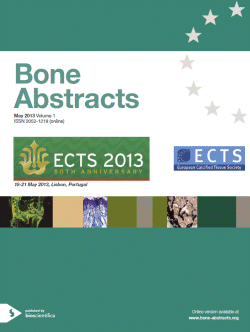Searchable abstracts of presentations at key conferences on calcified tissues

European Calcified Tissue Society Congress 2013
Lisbon,
Portugal
18 May 2013 - 22 May 2013

European Calcified Tissue Society Congress 2013, 18 - 22 May 2013; Lisbon, Portugal
Workshops
Fat and bone
ba0001w1.1 | Fat and bone | ECTS2013
Obesity, bariatric surgery and bone
For many years obesity has been considered to be protective against fragility fractures, since low BMI contributes to fracture risk. However, recent studies indicate that obese women represent a subset of patients with low-trauma fractures. In fact, obesity increases the risk of fracture at specific sites such as ankle, upper and lower leg and predictably, proximal humerus. By contrast, wrist, hip and pelvis fracture rates are lower in obese women. Interestingly, the majority ...
ba0001w1.2 | Fat and bone | ECTS2013
Anorexia nervosa and bone
Anorexia nervosa (AN) occurs in 0.21% of adolescent girls and is characterized by physiological and adaptive changes in the various endocrine axes. Changes also occur in many hormones secreted or regulated by fat (a reflection of energy stores) that can impact bone. The physiological changes observed in various endocrine axes in AN in turn cause impaired bone accrual rates, low bone density (associated with increased marrow fat) and impaired bone microarchitecture. This ...
ba0001w1.3 | Fat and bone | ECTS2013
Effects of fat on bone: location and age matter
The epidemiological evidence is clear that higher body weight is protective against most fractures in adults. However, the same may not be true in children. Understanding the mechanisms of interaction of fat and bone may give useful insights into underlying physiology for prevention of fracture.In general, higher body weight in adults is associated with higher bone mineral density and is protective against fracture, but may be associated with an increase...



